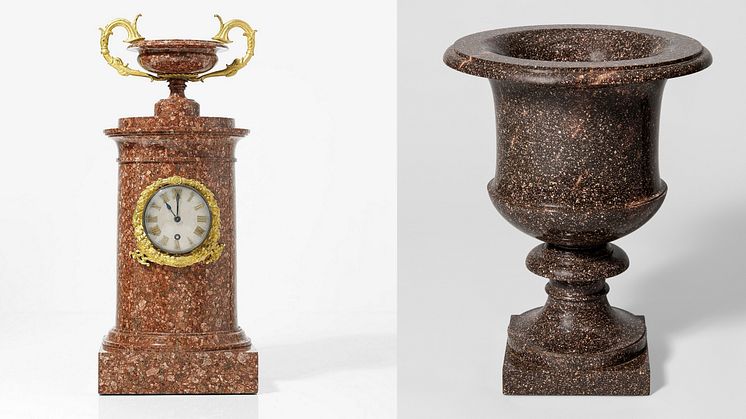
Press release -
New Acquisition: Works in Swedish porphyry
Nationalmuseum has added several artefacts made from Swedish porphyry to its collection. Porphyry was one of Sweden’s most coveted exports in the late 18th and for most of the 19th century. The museum recently purchased a pair of magnificent Medici-style vases with Swedish royal provenance at auction in the United States. In addition, the museum has acquired a table clock in granitell and an interesting specimen collection of various types of Swedish porphyry.
Deposits of porphyry in the Älvdalen region of central Sweden were discovered as far back as the 1730s, but it would be another half-century before quarrying started. The driving force behind the project, which to a large extent was socially motivated, was Count Niels Adam Bielke, president of the Swedish Board of Mines. The government’s goal was to create a sustainable industry that would bring prosperity to impoverished communities in Älvdalen. The porphyry works was officially established in 1788, a year after the first product, an urn, was presented to King Gustav III.
Porphyry, which takes its name from the Greek porphyros, a type of sea snail, has been a highly prized material since the time of the pharaohs. There were few known deposits, and for centuries Egyptian porphyry dominated the market. During and after the Renaissance it became common practice to turn fragments of porphyry from ancient buildings into ornaments. This igneous rock is extremely hard, so working with it requires special skill. A lot of time-consuming grinding and polishing is needed to achieve a high-gloss finish. Carl Fredrik Fredenheim, who had visited Italy as Gustav III’s representative, proposed trying to sell Swedish porphyry to the domestic market. But sales failed to take off, and it was to be several decades before large-scale production could begin in Älvdalen.
In fact, business did not pick up until King Karl XIV Johan took ownership of the bankrupt porphyry works in 1818, but even then it relied directly on the king for support. Karl Johan himself was the works’ biggest customer, ordering numerous ornaments as official gifts for foreign dignitaries or as tokens of royal favour bestowed on individuals.
An example is the pair of magnificent Medici-style vases in Blyberg porphyry recently purchased by Nationalmuseum at Sotheby’s in New York. They once belonged to Princess Sofia Albertina (1753–1829), sister of Gustav III, and probably adorned the interior of her residence on Gustaf Adolfs torg in Stockholm. Designed by Louis Masreliez, an artist employed by the porphyry works, the vases were bequeathed by the princess to her companion Lolotte Stenbock (1766–1840), whose descendants handed them down through the generations until 2001.
As well as showpieces, the porphyry works produced smaller artefacts, which were sold through its shop in Stockholm. From the outset, the objective was to bolster the prestige of Swedish porphyry, for instance by fitting ormolu (gilt bronze) mounts imported from France. The recently acquired table clock in the shape of a column on a square base, crowned by an urn, is made from granitell, a related material. Finished with bronze mounts and a clock mechanism from the late Karl Johan era, it is a superb example of the efforts made to move Swedish products upmarket.
The last of the three acquisitions during the past year was a unique collection of 30 specimens of porphyry and several closely related rock types from Älvdalen. Each specimen has a printed, numbered label specifying the rock type. The specimens are preserved in their original mahogany box and once belonged to Ludvig Bäärnhielm (1828–99), a student at the mining college in Dalarna.
When Nationalmuseum opened in 1866, several large porphyry pieces were donated to the museum by Dowager Queen Josefina, but smaller-scale artefacts have long been unrepresented. Thanks to their provenance and unique nature, the latest porphyry acquisitions constitute important additions to the collection. Nationalmuseum has no budget of its own for new acquisitions, but relies on gifting and financial support from private funds and foundations to enhance its collections of fine art and craft. These acquisitions were made possible by a generous endowment from Ulla & Gunnar Trygg and a generous donation from the Axel Hirsch Foundation.
Press contacts
Micael Ernstell, Curator, Applied Art and Design, micael.ernstell@nationalmuseum.se, +46 8 5195 4392
Hanna Tottmar, Press Officer, press@nationalmuseum.se, +46 767 234632
Categories
Nationalmuseum is Sweden’s premier museum of art and design. The collections comprise older paintings, sculpture, drawings and graphic art, and applied art and design up to the present day. The museum building is currently under renovation and scheduled to open again in 2018. In the meantime, the museum will continue its activities through collaborations both in Sweden and abroad as well as temporary exhibitions at Nationalmuseum Design at Kulturhuset Stadsteatern in Stockholm. Nationalmuseum has partnerships with Svenska Dagbladet and the Grand Hôtel Stockholm, and acknowledges the support of FCB Fältman & Malmén.

